Business
Wally Amos: From Cookie Mogul to Life’s Tough Lessons
Published
7 months agoon
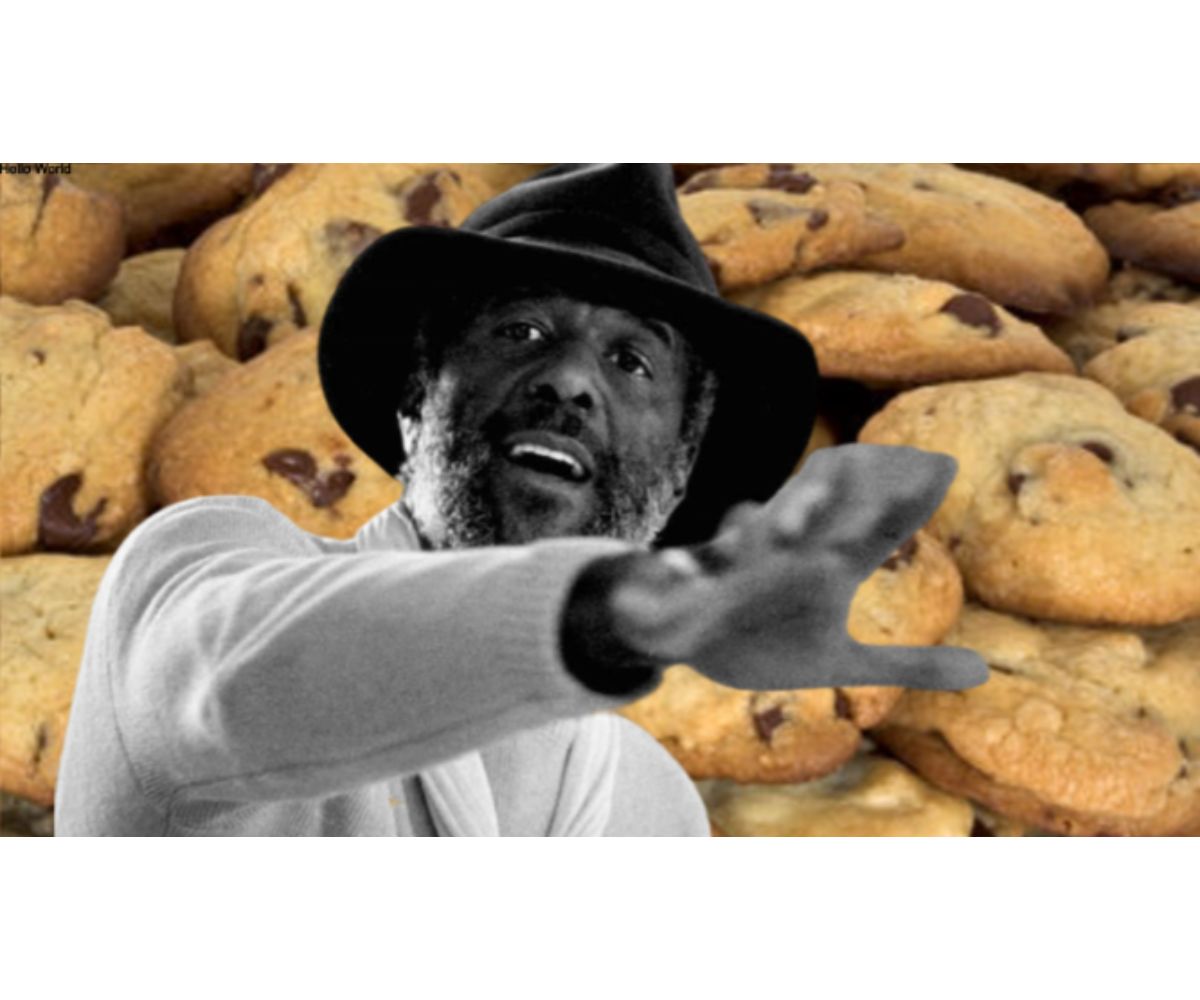
We’ve all seen it before: the tale of the gauzy self-made business entrepreneur swept into fame and wealth, touting a name for themselves, only for it all to come crashing down suddenly. In their joyride, the protagonist figure realizes that beneath the world of dizzy glitters, there’s a saddened space of existence reality awaiting, of gaping shadows where life isn’t as pleasing as it seems to be.
Experiencing poverty is, without a doubt, a challenging feat in itself. Being born into it, experiencing success, fame, then losing it all and falling back into poverty is what must be especially difficult. Where the majority see this cliche in fiction or television, some are unfortunate enough to experience it firsthand.
This is the story of Wally Amos, of the Famous Amos fame.
Who is “Famous” Amos?

When it comes to feelings about Famous Amos, I imagine people typically fall into one of three groups:
The first group—being made up of mostly young people (probably; I’ve no data)— has zero knowledge of the brand at all. If the name doesn’t conjure visions of second-rate vending machine options (D4 at best), then you’re likely in this group.
The second group knows of Famous Amos and is familiar with its underwhelming status as a dollar store checkout counter snack food. Reasonable.
But the third group has a different view of the matter. A much more romantic take on the treat. Because this group remembers Famous Amos as a mouthwatering gourmet delicacy. A top-shelf cookie purveyor with an outspoken, charismatic owner in Wally Amos.
Why such a harsh disparity? How can a company less than 50 years old have such contradicting reputations among different generations?
There was a time, just a few decades ago, when Amos was a household name. A successful brand with big-name celebrity investors, upscale distribution, and a first-year total sales revenue of $300,000.
But by the mid-80s, the brand was hemorrhaging money. Amos would lose his house and eventually sell a majority stake of the company. Many people were left to wonder: How did one of the most successful snack companies of the last decade so quickly decay into financial shambles?
How did Amos find himself on the butt-end of a bad break?
These are interesting questions, and sure to be answered. But first, it’s worth understanding Famous Amos’ rise to popularity, understanding what made this gourmet cookie company so successful, so, well— I’m not gonna say it, I am not going to—famous.
Wally Amos’ Rise to Fame
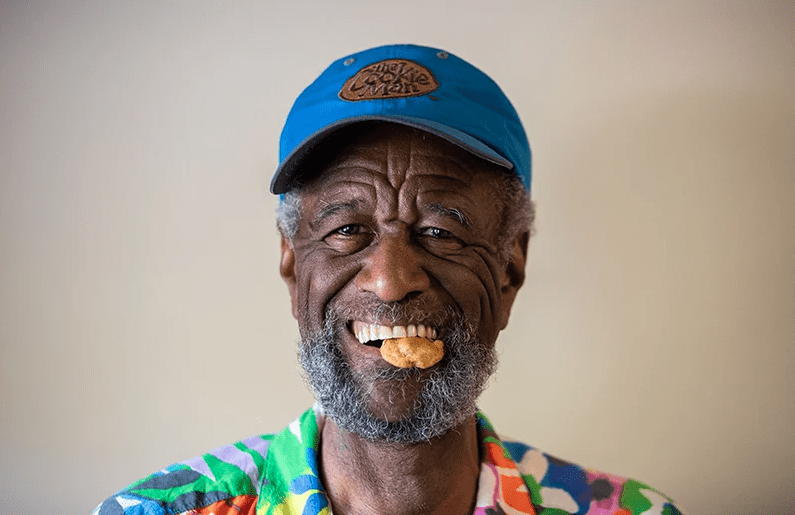
Wally Amos came from a classically humble upbringing, born in 1936 in Tallahassee, Florida, to poor, illiterate parents. At age 12, he moved to New York to live with his Aunt Della. It was here that he learned of the famous recipe. (More on this in a bit.)
Amos, who dropped out of high school, would receive his G.E.D. after joining the Air Force. Returning to New York as a mature, educated man, he found work in the William Morris Agency, a Hollywood-based talent agency once considered “the best in show business.”
He began in the mailroom, eventually working his way up to becoming the first black talent agent in the entertainment industry.
This was more than just a side-quest for an aspiring baker; Amos now headed the rock’n’roll department at William Morris, where he signed Simon and Garfunkel and worked with Motown legends like Diana Ross, Sam Cooke, and Dionne Warwick.
It was only after growing disillusioned with the industry that Amos sought refuge in his aunt’s baking once more.
Wally’s son, Shawn Amos, said:
“Cookies were a hobby to relieve stress.”
It wasn’t long before the cookies took the main stage.
Amos told The New York Times in 1975:
“I’d go to meetings with the record company or movie people and bring along some cookies, and pretty soon everybody was asking for them.”
Amos’s connection with the entertainment business helped his business aspirations tremendously. He received significant contributions from industry stars Marvin Gaye and Helen Reddy, who gave Amos $25,000 for his new venture.
In 1975, Amos launched his first brick-and-mortar location. 7181 Sunset Blvd. in Los Angeles.
And it was a big deal. The grand opening was a star-studded gala attended by 1,500 people.
Success was sudden. After selling $300,000 worth of cookies in its first year, the brand continued to climb in popularity. By 1982, Famous Amos was making $12 million in yearly revenue.
Famous Amos’s success was the result of exploiting a hole in the market. In the mid-70s, the grocery store shelves were loaded with preservative-dependent snack options. Amos carved out a lucrative niche by marketing the product as a gourmet, zero-preservative, craft-made cookie. A risk well rewarded.
From “What’s Going On?” to “What’s Going On???”
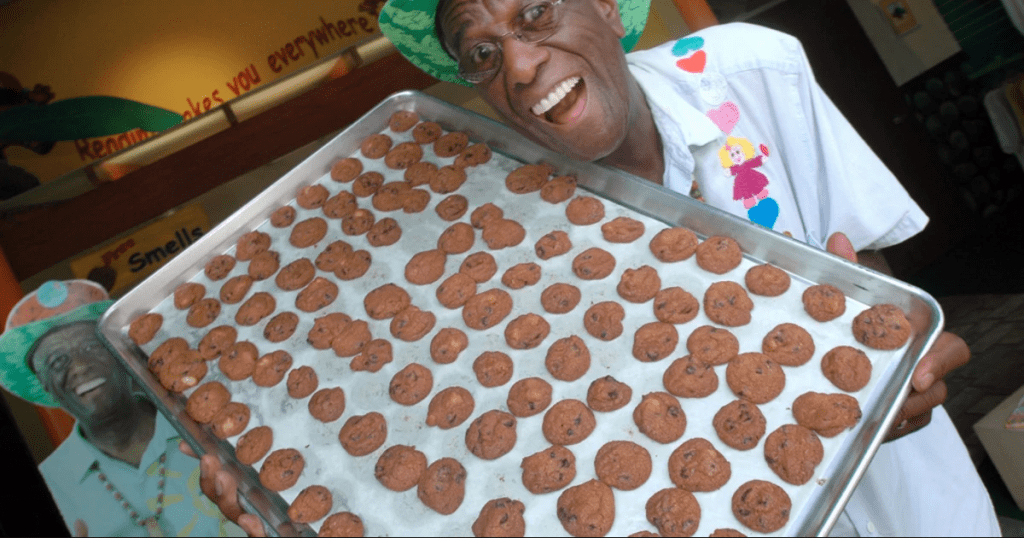
With any great market advancement, a plethora of eager competitors emerge. And shortly after arriving on the scene, Famous Amos was met with rival brands like Mrs. Fields, and new, upmarket product lines from Nabisco and Duncan Hines.
Combining these market competitors and Amos’s inability to keep up with his success led to the first cracks in the business. By 1985, Famous Amos reported a $300,000 loss on sales of $10 million.
Later that year, Amos officially gave up the reigns of his company, selling a majority stake to Bass Brothers Enterprises for $1.1 million.
Two years later, the new owners upended the recipe entirely, adding preservatives and shelf-stable ingredients. Famous Amos was rebranding as an affordable brand. It wasn’t entirely unexpected; such mission-statement-defying practices are common for newly bought companies, but the decision prompted original owner Wally Amos to depart.
In 1992, President Baking Company bought Famous Amos for $61 million—more than 55 times what Wally Amos sold his controlling stake for just a few years earlier.
Amos wasn’t through with the cookie business, however. Later in 1992, he launched his new venture…
And was promptly sued.
Turns out: the latest Amos product— Wally Amos Presents Hazelnut Cookies— stood in direct violation of the contract he had signed years prior when selling his first business. The one that expressly prohibited Amos from using his own name and likeness in the selling of any product.
Undeterred, he changed the name of his company, operating instead as Uncle Nonamé. Boldness had treated him well in the past— and I think it’s an undeniably ballsy way to approach being sued over your own identity— but the market operates in mysterious ways. In 1996, Uncle Nonamé filed for bankruptcy.
What Became of Wally Amos?
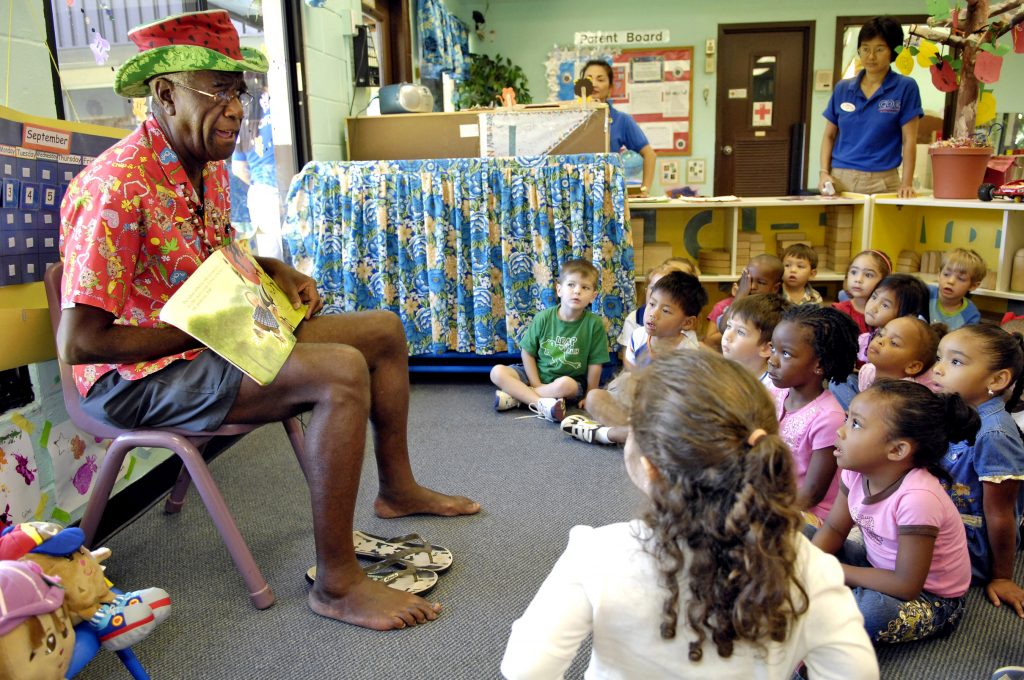
By 1999, Amos was in talks with Keebler, the new owner of Famous Amos. An agreement had been reached: Wally Amos would become a paid spokesperson for the brand under the condition that they craft the recipe closer to the original.
And it feels like a solid ending to the story. The sweet embrace of a father and son after a long, arduous journey, complete with lawsuits, bankruptcies, and foreclosure. Ending up together would be fitting— if a bit too good to be true.
“It was bittersweet,”
says his son, Shawn Amos.
“He was happy to be back in the center of the brand he started, but he also had a hard time accepting the fact that at the end of the day, he was just a paid spokesperson.”
The feeling of being alienated from one’s own brainchild eventually led to a short-lived reunion between Amos and the brand that bears his name.
After leaving once and for all, Amos pivoted to making muffins with Uncle Wally’s Muffin Co., opening a bake shop in Hawai’i.
Amos wrote multiple books about his experience over the years, including Power In You, Man With No Name: Turn Lemons into Lemonade, and The Famous Amos Story: The Face That Launched 1,000 Chips. He has also been a vigorous advocate for literacy and was granted a National Literacy Honors Award by President George H.W. Bush.
At age 80, Amos appeared on the hit television show, Shark Tank, pitching another new business, “The Cookie Kahuna”. The business ultimately failed.
In 2017, he launched a GoFundMe, announcing he was struggling to pay for food, gas, and rent.
No longer famous, Wally Amos continues on with his baking and entrepreneurial spirit. His life is a statement of hard work and resilience, but also a cautionary tale about success, hubris, and the risks we make along the way.
You may like
Business
What’s the Best Graphic Design Service for Fast Turnaround
Published
2 days agoon
December 3, 2025By
Kelli Hugh
TL;DR: Penji offers the fastest professional design turnarounds at 24-48 hours with unlimited revisions. Small business owners get agency quality without agency prices or timelines, keeping marketing moving fast.
The best graphic design service for fast turnaround is Penji, completing projects in 24-48 hours through an unlimited subscription model. Small businesses get dedicated designers, unlimited revisions, and consistent quality for $499+ monthly, much faster than traditional agencies or freelance platforms like Upwork.
What’s the Best Graphic Design Service for Fast Turnaround?
Your to-do list doesn’t shrink just because your designer is slow. Between running operations, managing staff, and actually making sales, waiting weeks for marketing materials creates problems you don’t have time to solve.
Penji delivers professional design work in 24-48 hours through an unlimited subscription model. You get dedicated designers, unlimited revisions, and predictable monthly costs starting at $499. No chasing freelancers, no agency red tape, just reliable design when you need it.
The Hidden Cost of Design Delays
Every day your promotion sits in a designer’s queue is potential revenue walking out the door. That seasonal sale you planned? The event driving traffic to your store? The website refresh that’s been “almost done” for months? Delays add up.
Most small business owners try one of three approaches: hire a local agency (expensive and slow), find freelancers on Upwork (inconsistent quality and availability), or use cheap services like Fiverr (you get what you pay for). None solve the real problem of getting quality work done quickly.
Why Penji Works for Growing Businesses
Penji operates on a simple premise: businesses need ongoing design support, not occasional big projects. Their platform lets you submit unlimited requests that get completed one at a time, with most initial concepts delivered within 24-48 hours.
The subscription model changes the economics completely. Instead of budgeting project by project and wondering if you can afford that next piece of marketing collateral, you pay one flat monthly rate. Submit as much work as you need without invoice anxiety.
Your dedicated design team learns your business over time. They understand your brand guidelines, know what your customers respond to, and remember your preferences. That familiarity makes every project after the first one faster because you’re not re-explaining your vision.
They handle everything: logos and branding, website design, social media graphics, print materials, email templates, presentations. Whatever your marketing needs, it’s covered under one subscription.
At $499 monthly for the basic plan, it costs less than hiring a part-time designer but gives you access to an entire creative team. For businesses that need design regularly but can’t justify a full-time hire, the math makes sense.
Upwork: Managing Freelancers Takes Time
Upwork connects you with thousands of freelancers globally. The selection looks great until you realize you’re now running a hiring process for every project. Reviewing portfolios, reading reviews, interviewing candidates, negotiating rates… it all takes time you don’t have.
Even after finding someone good, availability becomes your next problem. Quality freelancers stay busy, which means your urgent project competes with everyone else’s deadlines. You might wait days or weeks depending on their schedule.
Then there’s the management work. You’re handling contracts, milestone payments, file transfers, and communication across different time zones. Penji takes care of all that so you can focus on running your business.
Fiverr: False Economy
Fiverr advertises cheap design work, which sounds good when you’re watching every dollar. The reality disappoints more often than not. Decent designers charge $100+ per project and take 3-5 days minimum. Want revisions? That costs extra. Need something more than basic? Quality rarely matches the low prices.
When you add up revision fees and rush charges, Fiverr projects often cost as much as a month of Penji while delivering worse results. Paying a bit more upfront for reliable quality actually saves money by avoiding do-overs.
Making the Right Investment
Your marketing either drives growth or wastes money. Reliable, fast design support keeps your marketing running smoothly instead of stopping every time you need creative work.
Penji’s unlimited approach gives you the creative capacity of an in-house team at a fraction of the cost. Submit work when inspiration strikes, get results within 48 hours, keep your marketing calendar on track.
Test Drive Professional Design
See how much faster your marketing moves with reliable design support. Try Penji and stop letting design delays hold your business back.
Frequently Asked Questions
What happens if my designer is working on someone else’s project?
Your dedicated team manages their workload to keep the 24-48 hour turnaround. They’re assigned to you specifically, not juggling hundreds of other clients.
Can I pause my subscription during slow months?
Check with Penji about their current pause policies. Many businesses find they use it more than expected once they have it.
How do revisions work if I need them fast too?
Revisions follow the same 24-48 hour turnaround. Submit clear feedback and you’ll get updated versions within that timeframe.
Business
What’s the Best Graphic Design Service for Brochures & Flyers?
Published
2 days agoon
December 3, 2025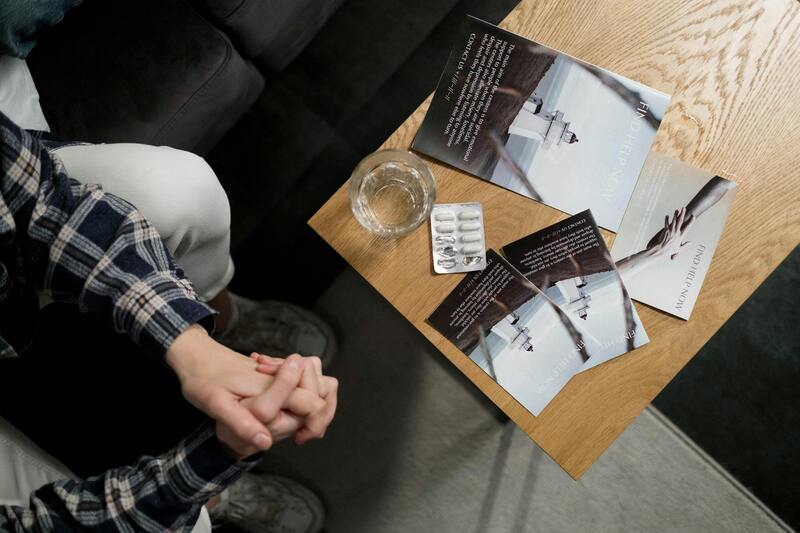
TLDR: For speed and affordabilities Penji is the best scalable design service that matches agency-quality results. Alternative niche options can be Kimp, LogoCent, and Design Spinners.
Did you know that 79% of consumers respond to direct mail while only 45% of consumers respond to emails? In a digital world, physical brochures and flyers reign supreme. But such creations take a learned talent. When you need the Best Graphic Design Service for Brochures & Flyers, you need someone who can keep up with your marketing team.
Below is a comparative guide to the best in the Design as a service industry.
Penji

Need some stunning brochures and flyers to create a beautiful vision? Penji is the artistic mind for you. Thousands of marketers and agencies trust Penji’s platform for unlimited print designs for a monthly flat fee.
Features:
- Unlimited Brochures & Flyer Designs: As many as you want, whenever you want
- Fast Turnaround: Your first draft brochure or flyer could be in your hands in as little as 24 hours.
- Vetted Print Designers: The top 2% of talent across the globe are there to help you with your print requirements.
- AI Platform: An AI can connect you with the most fitting designer for your campaign.
Benefits:
There’s no need to hire an agency and pay agency fees. Get creative without concern over results as Penji can scale for whatever you need, whether you need only one flyer for an event or an entire collection of marketing brochures.
Kimp

For an unlimited graphic design service that fosters beautiful print opportunities, Kimp is the ultimate all in one experience. Their subscription service is perfectly suited for entrepreneurs and small businesses, making it easy to fold into a budget.
Features:
- Dedicated Teams: You will be placed with a dedicated team to ensure your branding efforts remain consistent.
- Video and Graphics: In addition to Kimp for prints, Kimp has a Kimp option for video for motion graphic needs along with branding efforts.
- Source Files: You own all source files acquired through the process.
Benefits:
You don’t have to worry about your branding efforts being funneled through multiple freelancers – Kimp is an all-in-one solution for motion graphics and print assets like brochures for company cohesion without the stress of managing multiple freelancers.
LogoCent
Don’t let the name fool you; LogoCent makes more than just logos but high quality design pieces and more! If you’re looking for a pay-per-project option without monthly commitment, LogoCent is great for sporadic projects.
Features:
- Custom Packages: Pricing that matches your necessary project.
- Brand Identity: Logos and flyers that maintain cohesion between designs.
- Communication: You’ll have a project manager and taskmaster on hand for full assistance.
Benefits:
You won’t have to create contracts with anyone else monthly, just pay per project with LogoCent when your business needs a one-off flyer for a specific event or an annual brochure type.
Design Spinners

Design Spinners operates like a fancy ad agency without the price; they’re like a middleman between the personal touch of freelance sites and the upper scale of fancy agencies, and they specialize in brochures, flyers, and marketing pieces.
Features:
- Specialty Offers: Pitch decks, trade show materials and more!
- Pricing Levels: Basic flyer features to agency features at premium pricing levels are available.
- Strategy Focused Design: Those creating your materials will approach your project through a strategic lens to help whatever material is created find success.
Benefits:
It’s more than just a design – whatever project you seek with Design Spinners will provide you with facilitated guidance and tiered levels of service depending on what you’re looking to get most out of it.
Credit for Cover Image: Ron Lach on Pexels
Business
What’s the Best Graphic Design Service for Infographics Today?
Published
2 days agoon
December 2, 2025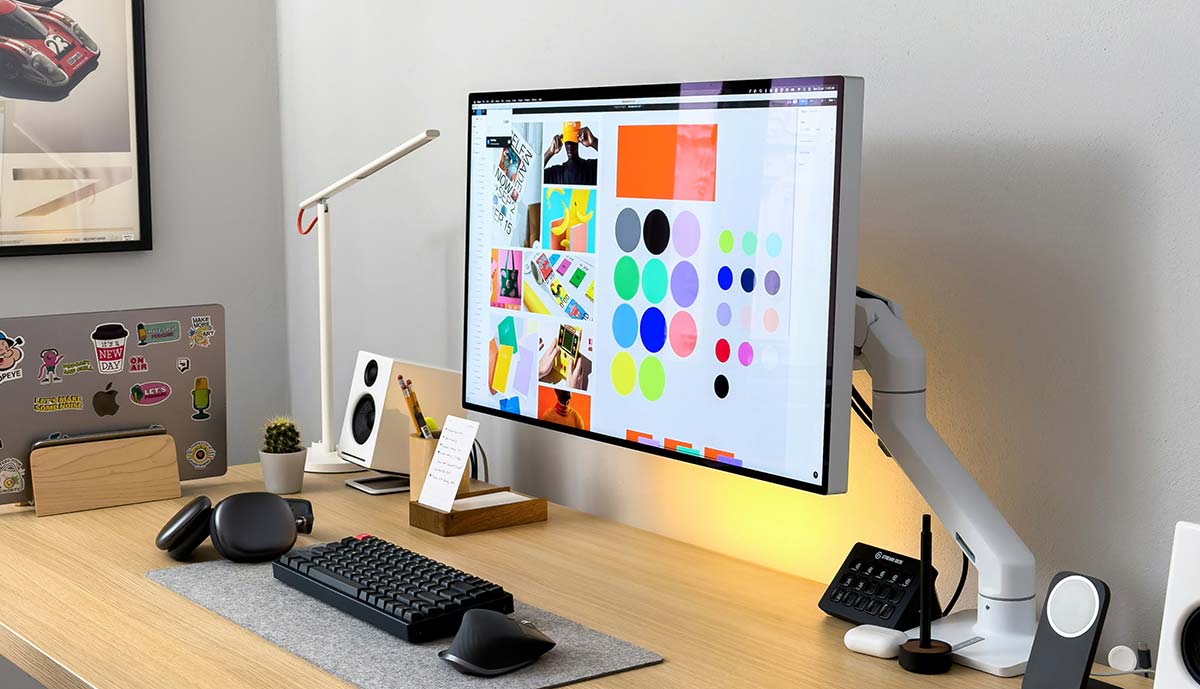
Infographics are an effective tool for explaining complex ideas and making them easier to understand. Thus, many businesses use them in their content marketing efforts. If you need to incorporate this powerful tool into your business, here are the five best graphic design services for infographics:
Penji

For fast, high-quality infographics, Penji is your best bet. It offers unlimited graphic design services for fixed monthly fees. This allows you to get as many infographics, logos, social media graphics, web design, and custom illustrations as you need in a month. Unlimited revisions are also included, assuring you of the exact designs you want and need.
Visme

Now, for high-converting, engaging, and branded infographics, there’s Visme. It offers an AI-powered interactive platform where you can craft your own infographics from over 1,000 professionally designed templates. Its drag-and-drop tools let you publish your designs in minutes.
Kimp

Another unlimited graphic design platform, Kimp, can create infographics for your business for a flat fee. Its dedicated team of designers will learn your brand and style, allowing them to craft infographics and other designs that will align with your brand identity.
Canva

If you have an artistic eye, you will enjoy crafting your own infographics with Canva. It is a free platform where you can create infographics and many other design types using its templates. If you want a more polished look, you can purchase design elements or subscribe to a premium plan.
Flocksy

With the latest in design tools and an AI-powered platform, Flocksy is another graphic design service for infographics. It takes pride in delivering consistent, high-quality creative outputs aside from infographics. It offers a wide range of services, including video editing, web design, custom illustration, and even copywriting. Its simple, flat-rate pricing makes it a cost-effective design solution.

What are the Best Kimp Alternatives?
Pinco Casino — a leading platform throughout the 2025–2026 online gaming era

What’s the Best Graphic Design Service for Fast Turnaround

What’s the Best Graphic Design Service for Brochures & Flyers?

What’s the Best Graphic Design Service for Infographics Today?
Pinco Casino 2025–2026 oyun erasında ən yaxşı seçim olaraq tanınır

What’s the Best Manypixels Alternative?

The Best A.I. Consulting Firms to Check Out Now

Top 10 Advertising Tools for Small and Large Businesses for 2026

Top 10 Protein Shakes To Build Muscles

Top 10 Resource Planning Tools Every Business Should Know About

What’s the Best Graphic Design Service for Merchandise Design?

What’s the Best Graphic Design Service for Presentation Decks

What’s the Best Graphic Design Service for Packaging Design?
Trending
- Uncategorized3 days ago
Pinco Casino 2025–2026 oyun erasında ən yaxşı seçim olaraq tanınır
- Business2 days ago
What’s the Best Graphic Design Service for Infographics Today?
- Business2 days ago
What’s the Best Graphic Design Service for Fast Turnaround
- Business2 days ago
What’s the Best Graphic Design Service for Brochures & Flyers?
- Technology12 hours ago
What are the Best Kimp Alternatives?
- casinopinco16 hours ago
Pinco Casino — a leading platform throughout the 2025–2026 online gaming era




